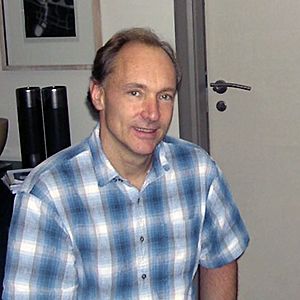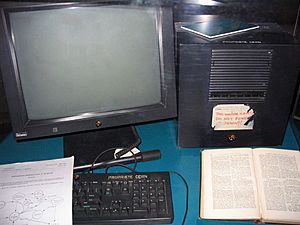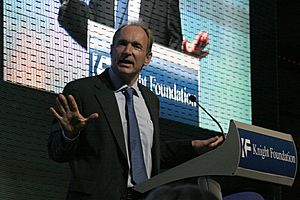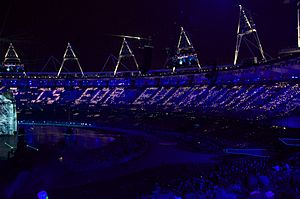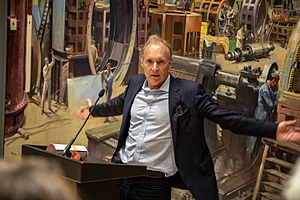Tim Berners-Lee facts for kids
Quick facts for kids
Tim Berners-Lee
|
|
|---|---|
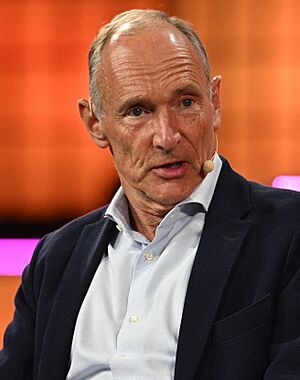
Berners-Lee in 2024
|
|
| Born |
Timothy John Berners-Lee
8 June 1955 London, England
|
| Other names |
|
| Education | Queen's College, Oxford (BA) |
| Known for | Invention of the World Wide Web |
| Spouse(s) |
Nancy Carlson
(m. 1990; div. 2011)Rosemary Leith
(m. 2014) |
| Children | 2 children 3 step-children |
| Parents |
|
| Awards |
|
| Scientific career | |
| Fields | Computer science |
| Institutions | |
| Signature | |
 |
|
Sir Timothy John Berners-Lee (born 8 June 1955), often called TimBL, is a British computer scientist. He is famous for inventing the World Wide Web, which is the system of linked documents and other web resources that you can access over the Internet. He also created the basic parts of the Web, like HTML (the language for making web pages), URLs (web addresses), and HTTP (the rules for how web pages are sent).
Berners-Lee first suggested a system to manage information on 12 March 1989. By November of that year, he had successfully made the first connection between a web browser (HTTP client) and a web server over the Internet. He built the very first web browser and web server himself. He also helped the Web grow into what it is today.
He is the founder and director emeritus of the World Wide Web Consortium (W3C). This group makes sure the Web continues to develop and works well for everyone. He also helped start the World Wide Web Foundation. In 2004, Queen Elizabeth II knighted him for his amazing work. In 2016, he received the Turing Award, which is like the Nobel Prize for computing. He was also named one of the "100 Most Important People of the 20th Century" by Time magazine.
Contents
Early Life and Education
Tim Berners-Lee was born in London, England, on 8 June 1955. His parents, Mary Lee Berners-Lee and Conway Berners-Lee, were both mathematicians and computer scientists. They worked on one of the first computers made for businesses.
As a child, Tim loved trainspotting and learned about electronics by playing with a model railway. This early interest in how things work helped him later in life.
From 1973 to 1976, he studied physics at The Queen's College, Oxford. While at university, he even built his own computer using an old television set!
Creating the World Wide Web
After college, Berners-Lee worked as an engineer at different companies. In 1980, he worked as a contractor at CERN in Switzerland. CERN is a big science lab where researchers share a lot of information. Tim saw a problem: it was hard for scientists to share and update their notes and ideas.
He came up with an idea based on "hypertext." Hypertext lets you link different pieces of information together. To show how it would work, he built a test system called ENQUIRE.
In 1989, Berners-Lee realized that he could combine his hypertext idea with the Internet. He thought, "What if all the documents in the world could be linked together?" This led to his proposal for the World Wide Web.
His manager at CERN, Mike Sendall, thought his idea was "vague, but exciting." So, Berners-Lee started working on it. He teamed up with Robert Cailliau, who also had similar ideas. Together, they used ideas from the ENQUIRE system to create the World Wide Web.
Berners-Lee designed and built the very first web browser, which he called WorldWideWeb. This software also worked as an editor, letting people create web pages. He also built the first Web server, called CERN HTTPd.
On 20 December 1990, Berners-Lee published the first-ever website. It explained what the World Wide Web was, how to use a browser, and how to set up your own web server. On 6 August 1991, he invited others to join the WorldWideWeb project.
The invention of the World Wide Web has been called one of the most important cultural moments in history. It changed how people connect and share information around the globe.
Making the Web Free for Everyone
In 1994, Berners-Lee started the W3C (World Wide Web Consortium) at the Massachusetts Institute of Technology (MIT). This group brings together different companies to create standards for the Web. These standards help make sure that websites work the same way for everyone, no matter what computer or browser they use.
One of the most important things Berners-Lee did was to make his idea for the Web available for free. He didn't patent it or charge any fees. This meant that anyone could use his ideas to build websites and web tools without paying royalties. This decision helped the Web grow incredibly fast because it was open for everyone to use and develop.
In 2009, Berners-Lee joked that the "//" (double slashes) in web addresses were "unnecessary." He said he could have designed web addresses without them, but "it seemed like a good idea at the time."
Working for a Better Web
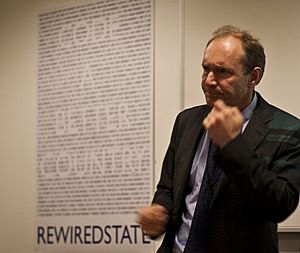
Tim Berners-Lee has continued to work on making the Internet better and more open. In 2010, he helped create data.gov.uk, a project that makes government information available to the public. He believes that information should be open unless there's a very good reason for it to be private.
In 2009, he launched the World Wide Web Foundation (WWWF). This foundation works to make sure the Web is a safe and useful tool for everyone, especially in developing countries.
Berners-Lee is a strong supporter of net neutrality. This idea means that Internet providers (ISPs) should treat all data on the Internet equally. They shouldn't block or slow down certain websites or apps. He believes that net neutrality is a basic human right for using the Internet. He has spoken out against companies or governments that try to control or snoop on Internet traffic.
In 2012, Berners-Lee was honored at the 2012 Summer Olympics opening ceremony in London. He appeared working on a vintage computer, and his tweet "This is for everyone" was displayed in lights around the stadium. This message showed his belief that the Web should be for everyone.
Since 2012, he has been the president of the Open Data Institute, which he co-founded. This organization helps make more data available for public use.
In 2013, Berners-Lee helped launch the Alliance for Affordable Internet (A4AI). This group works to make Internet access cheaper, especially in developing countries where many people are still offline. They want to make sure that Internet access costs less than 5% of a person's monthly income.
Berners-Lee is also leading a project called Solid. This project aims to give people more control over their personal data online. Instead of companies owning your data, Solid wants to let you choose where your data is stored and who can see it.
In 2019, Berners-Lee and the WWWF launched the Contract for the Web. This campaign encourages governments, companies, and people to follow nine principles to prevent the Web from being misused. He warns that if we don't act, the Web's potential for good could be lost.
Awards and Recognition
Tim Berners-Lee has received many awards for his groundbreaking work.
- In 2004, Queen Elizabeth II made him a Knight, so he became "Sir Tim Berners-Lee."
- In 2007, he was given the Order of Merit (OM), a special honor given by the King or Queen to only 24 living people.
- He became a Fellow of the Royal Society in 2001, which is a very high honor for scientists.
- Many universities around the world, including Harvard and Yale, have given him honorary degrees.
- In 2013, he received the first-ever Queen Elizabeth Prize for Engineering.
- In 2017, he received the Turing Award for inventing the World Wide Web, the first web browser, and the basic rules that allowed the Web to grow so much.
Personal Life
Tim Berners-Lee likes to keep his work and personal life separate. He married Nancy Carlson, an American computer programmer, in 1990. They had two children and later divorced in 2011. In 2014, he married Rosemary Leith. She is a Canadian entrepreneur and also a founding director of the World Wide Web Foundation.
Berners-Lee was raised in the Anglican church but later became a Unitarian Universalist. When asked about his beliefs, he has said he is an atheist and a Unitarian Universalist.
In 2021, the original source code for the Web was sold as a non-fungible token (NFT) for over $5 million. The money from this sale was used to support initiatives by Tim Berners-Lee and Rosemary Leith.
See also
 In Spanish: Tim Berners-Lee para niños
In Spanish: Tim Berners-Lee para niños


